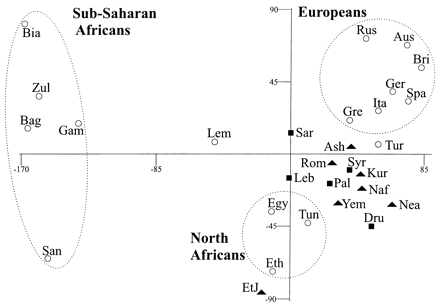The advancements in DNA have been able to trace family relationships and prove parenthood beyond any doubt. Could this DNA research tell us if:
- Jews were related to the Arabs and whether they shared a common family heritage?
- Was there a Levite (Kohen) genetic marker that traced the descendants of Levi – the Priesthood.
“Jews and Arabs are all really children of Abraham,” says Harry Ostrer, M.D., Director of the Human Genetics Program at New York University School of Medicine. “And all have preserved their Middle Eastern genetic roots over 4,000 years,” he says.
The researchers analysed the Y chromosome, which is usually passed unchanged from father to son, of more than 1,000 men worldwide. Throughout human history, alterations have occurred in the sequence of chemical bases that make up the DNA, leaving variations that can be pinpointed with modern genetic techniques. Related populations carry the same specific variations. In this way, scientists can track descendants of large populations and determine their common ancestors.
Specific regions of the Y chromosome were analysed in 1,371 men from 29 worldwide populations, including Jews and non-Jews from the Middle East, North Africa, sub-Saharan Africa, and Europe.
The study, published in the Proceedings of the National Academy of Sciences, found that Jewish men shared a common set of genetic signatures with non-Jews from the Middle East, including Palestinians, Syrians, and Lebanese. These signatures diverged significantly from non-Jewish men outside of this region. Consequently, Jews and Arabs share a common ancestor and are more closely related to one another than to non-Jews from other areas of the world. The study also revealed that despite the complex history of Jewish migration in the Diaspora (the time since 556 B.C. when Jews migrated out of Palestine), Jewish communities have generally not intermixed with non-Jewish populations. If they had, then Jewish men from different regions of the world would not share the same genetic signatures in their Y chromosome. It is possible to calculate from the divergence of the Y-chromosomes how much intermarriage there was over the last 2,000 years. The answer is a striking 0.5 percent per generation.
A similar study published in British science journal, Nature (January 2, 1997), asked that participants in Israel, England, and North America to contribute DNA material and identify whether they were Kohen or could identify their family background.
The results of the analysis of the Y chromosome markers of the Kohanim and non-Kohanim were indeed significant. According to Rabbi Yaakov Kleiman in his article “The DNA Chain of Tradition: The Discovery of the ‘Cohen Gene,’” one scientific study found that 98.5% of Cohens tested share the same genetic marker, which signifies descent from a common male ancestor. Astonishingly, Cohen progeny from both the Sephardic (Arab-Muslim world) and Ashkenazic Jewish (European) groups share the same sequence. Judging by the number of mutations that has occurred in the Cohen haplotype, scientists conclude that the Cohens descend from one man who lived approximately 3,300 years ago.(A haplotype is a group of genes within an organism that was inherited together from a single parent.)
In a second study, Dr. Skorecki and associates gathered more DNA samples and expanded their selection of Y chromosome markers. Solidifying their hypothesis of the Kohens’ common ancestor, they found that a particular array of six chromosomal markers were found in 97 of the 106 Kohens tested. This collection of markers has come to be known as the Cohen Modal Haplotype (CMH)–the standard genetic signature of the Jewish priestly family. The chances of these findings happening at random is greater than one in 10,000.
The finding of a common set of genetic markers in both Ashkenazi and Sefardi Kohanim worldwide clearly indicates an origin pre-dating the separate development of the two communities around 1000 C.E.
Professor Hammer was recently in Israel for the Jewish Genome Conference. He confirmed that his findings are consistent that over 80 percent of self-identified Kohanim have a common set of markers.
The findings exposed two common myths
- The biblical assertion that the Samaritans were not proper Jews was unjustifiable and politically motivated. The Samaritan DNA shows that the lineage of this group is even more homogeneous and over a longer time than that of the Jews who returned from the Babylonian captivity. The fact that from Ezra’s time onwards Jewish teaching prohibited marriage between Jews and non-Jews – reinforced later by Christian rulers also forbidding it – contributes mightily to Jewish genetic identity.
- The Christian Identity and British Israelism (also called Anglo-Israelism) is a doctrine based on the hypothesis that people of Western European and Northern European descent are the direct lineal descendants of the Ten Lost Tribes of the ancient Israelites. DNA proves this is a fairy tale.
Two books make for interesting reading:
Abraham’s Children: Race, Identity, and the DNA of the Chosen People by Jon Ernstein.
DNA and Tradition: The Genetic Link to the Ancient Hebrews by Rabbi Yaakov Kleiman.